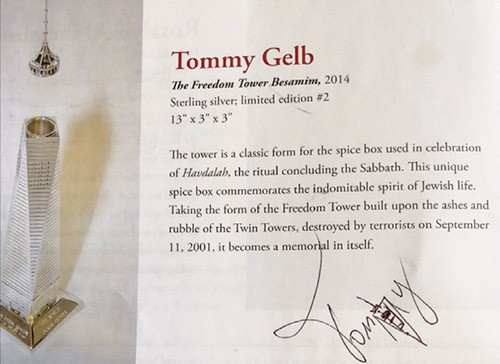




How many people do you know who have a deployed qassam scud missile head sitting on the shelf of their living room or study?
Thomas Gelb does.
An avid Judaica collector, Gelb was born in Czechoslovakia shortly after World War Two. Both of his parents were Holocaust survivors, and the entire family immigrated to the United States just before the short-lived 1968 anti-communist uprising staged by the Czech citizens, that was suppressed by the Soviet Union.
Gelb’s passion for collecting began at a young age, with colorful crystals and mineral rocks, and later stamps and wine labels. Later, traveling the world with his family, he developed a new interest in collecting while visiting the local Jewish museums and synagogues.
In Prague, he happened into a unique and rare Bohemian besamim (spice) tower. He was determined to acquire this piece, sensing a strong connection to his Jewish roots. Studying and looking deeper into this beautiful spice vessel’s history and reading about the Havdala ceremony, he became interested in the mystical ceremony called Havdala, and thus began his collection of besamim vessels of the world. Amongst Gelb’s collection of spice boxes are antique and old important pieces from seventeenth century Italy, as well as numerous European rare pieces, and pieces owned by celebrities. Gelb also owns many pieces created by current and prominent silversmiths, known primarily by sterling silver dealers and art collectors: the world renowned Yaacov Agam, Yehuda (Ludwig) Wolpert, David Gumbel, Menachem Berman and many others.
One of Gelb’s recent acquisitions is a spice box he commissioned by Israeli artist Yaron Bob. Bob’s studio named fittingly, “Rockets to Roses,” uses shrapnel and remains of partially exploded qassam scud missiles that were shot into Israel. Gelb notes that his piece was the artist’s first besamim holder.
Gelb is in the process of cataloging his now enormous collection, and in the midst of publishing an illustrated coffee table book. He shared some of his thoughts about being a collector of this special kind of art.“I buy with my heart. I prefer to hold the piece in my hand, not just see photos or view on the internet. I look for hallmarks and style to make sure they match. A piece has to be unique, special and attractive. I have to love the piece, and after confirming that it is authentic; only then do I determine whether to purchase [it].”
Discussing what affects the value of a piece the most, Gelb discussed the material most commonly used for besamim holders or boxes. “Spice vessels in the past were constructed of various materials, including: silver, brass, bronze, pewter, gold, wood, and porcelain. I also have Dead Sea stone-carved besamim holders, and even some made from seashells. In the past they were constructed out of materials that a person could afford, sometimes even converted from household items, like sugar boxes and salt shakers. The value of an antique besamim holder (mainly in silver or filigree) is determined by age, rarity and provenance.”
Questioned about possible plans to “take the collection on the road,” as an exhibit at Jewish historical or Judaica art museums, Gelb had this to say. “Once my book—my lifetime dream—is completed, I will be willing to show and share my collection and educate interested parties of our rich Jewish heritage.”
Gelb notes that there are many dealers and collectors who have expressed interest in purchasing pieces from his collection. “I do not currently sell, and will reconsider only when my book is complete.” Gelb also plans to either donate some pieces to museums for the public to enjoy, or possibly auction some of them, so that anyone can end up with a desired piece in their home.
Gelb quips that his “meshugas” of collecting inspired him to create his own spice tower, which has been on display at several museums. While involved in the construction business, he modeled a spice box after a building he was working on.
By Ellie Wolf









